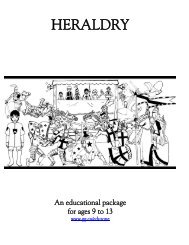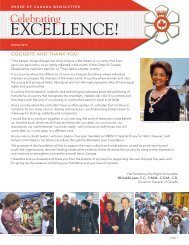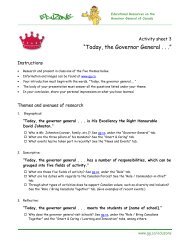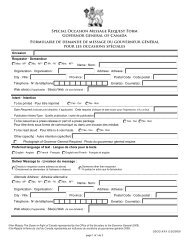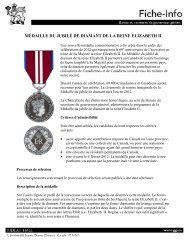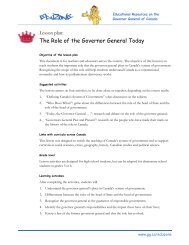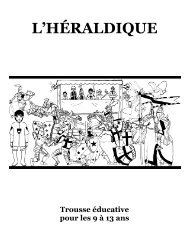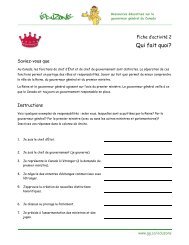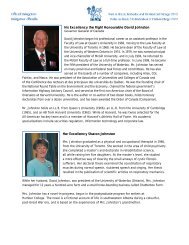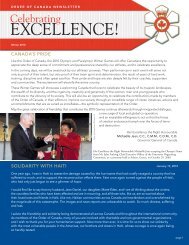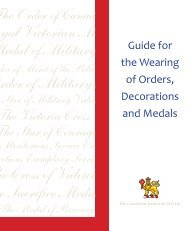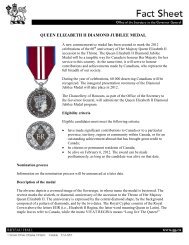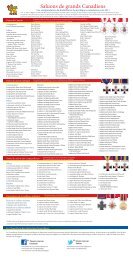Heraldry—An Educational Package for Ages 9 to 13
Heraldry—An Educational Package for Ages 9 to 13
Heraldry—An Educational Package for Ages 9 to 13
Create successful ePaper yourself
Turn your PDF publications into a flip-book with our unique Google optimized e-Paper software.
HERALDRY<br />
An educational package<br />
<strong>for</strong> ages 9 <strong>to</strong> <strong>13</strong><br />
www.gg.ca/eduzone
2 | 41 www.gg.ca/eduzone
HERALDRY IN CANADA<br />
An <strong>Educational</strong> package and<br />
activities <strong>for</strong> teachers and students<br />
University of<br />
Ottawa<br />
Produced by the Department of His<strong>to</strong>ry of the<br />
University of Ottawa<br />
in collaboration with the<br />
Canadian Heraldic Authority<br />
Canadian Heraldic<br />
Authority<br />
www.gg.ca/eduzone 3 | 41
HERALDRY IN CANADA<br />
Teacher’s Guide 5<br />
Introduction <strong>to</strong> the educational package 5<br />
What is heraldry? 7<br />
Where does heraldry come from? 8<br />
What is a herald? 11<br />
Who could have a coat of arms? <strong>13</strong><br />
What are the parts of a coat of arms? 14<br />
A Heraldic Inven<strong>to</strong>ry: Shapes, Fauna, Flora, and the Human Body 15<br />
How does heraldry work? 17<br />
How is a coat of arms used? 20<br />
What are some special features of Canadian heraldry? 22<br />
Student’s Guide 23<br />
Activities 26<br />
It’s your turn <strong>to</strong> be a herald: create your own arms 26<br />
Hidden words 27<br />
Scrambled words 28<br />
The arms of Canada 29<br />
What doesn’t belong? 31<br />
Colouring pages 32<br />
Answer Key 35<br />
Glossary 37<br />
Bibliographical Resources 39<br />
Evaluation Form 40<br />
This package was produced by the Department of His<strong>to</strong>ry of the<br />
University of Ottawa<br />
in collaboration with the Canadian Heraldic Authority<br />
© juin 2004<br />
4 | 41 www.gg.ca/eduzone
TEACHER’S GUIDE<br />
INTRODUCTION TO THE EDUCATIONAL PACKAGE<br />
HERALDRY IN CANADA<br />
This educational package originated with the wish of the Department of<br />
His<strong>to</strong>ry of the University of Ottawa and the Canadian Heraldic Authority <strong>to</strong><br />
establish links with schools, <strong>to</strong> familiarize young people with heraldry as well as<br />
with the Middle <strong>Ages</strong>, and <strong>to</strong> allow teachers <strong>to</strong> benefit from the specialized<br />
his<strong>to</strong>rical knowledge of the Department and the Authority.<br />
To realize these goals, the package is designed <strong>to</strong>:<br />
1. Be linked with a program of study <strong>for</strong> students ages 9 <strong>to</strong> <strong>13</strong>, and<br />
which can draw on knowledge from many disciplines, including<br />
his<strong>to</strong>ry, art, geography, and English.<br />
2. Encourage students, through the activities <strong>to</strong> develop a number of<br />
complementary skills, including research, artistic design, public<br />
speaking, group work, creativity, the ability <strong>to</strong> listen and observe,<br />
etc.<br />
3. Show teachers and students the importance of a knowledge of<br />
his<strong>to</strong>ry related <strong>to</strong> daily life, aspects of society, individual people<br />
and his<strong>to</strong>rical events.<br />
4. Describe the features, the use and the role of coats of arms in the<br />
Middle <strong>Ages</strong> and in modern-day Canada; describe how and why<br />
individuals wish <strong>to</strong> remember the past and preserve their heritage;<br />
and identify what has changed and what has remained the same<br />
between the past and the present.<br />
5. Stimulate self-awareness and allow the student <strong>to</strong> express his or<br />
her identity (origins, his<strong>to</strong>ry, etc.) and that of his or her classroom<br />
group.<br />
www.gg.ca/eduzone 5 | 41
We have attempted <strong>to</strong> produce a package that is as lively and creative as<br />
possible in order <strong>to</strong> encourage student participation and the acquisition of general<br />
knowledge that will be useful <strong>to</strong> them in their academic development and in their<br />
lives.<br />
Xavier, the herald, will follow them throughout the<br />
different sections. Each section may be used by itself, so that it<br />
may be incorporated in<strong>to</strong> other teaching units, such as fine arts,<br />
personal development, geography, his<strong>to</strong>ry, and English.<br />
We have also included in this package several documents<br />
that can be used as additional resources <strong>for</strong> teachers and<br />
students. We hope that these will be useful <strong>to</strong> you.<br />
The package includes the following items:<br />
a teacher’s guide<br />
a student’s guide<br />
activities <strong>to</strong> pho<strong>to</strong>copy <strong>for</strong> the students<br />
a glossary<br />
a bibliography<br />
an evaluation <strong>for</strong>m<br />
a procedure guide describing how <strong>to</strong> obtain a grant of arms from the<br />
Canadian Heraldic Authority, which you can obtain at<br />
http://www.gg.ca/heraldry/pg/index_e.asp<br />
an info sheet of the arms of the Governor General<br />
a pamphlet <strong>for</strong> the his<strong>to</strong>ry program at the University of Ottawa<br />
a pamphlet <strong>for</strong> the medieval studies program at the University of Ottawa<br />
We hope that you and your students will have as much fun and interest in<br />
exploring heraldry as we have had in preparing this package.<br />
N.B. Please feel free <strong>to</strong> pho<strong>to</strong>copy the various parts of this package <strong>to</strong> use in class.<br />
6 | 41 www.gg.ca/eduzone
What is heraldry?<br />
Heraldry is the study of coats of arms, in the same way that mathematics is<br />
the study of numbers. A coat of arms is an emblem in colour belonging <strong>to</strong> an<br />
individual or a corporate body, its arrangement and <strong>for</strong>m being subject <strong>to</strong> specific<br />
rules 1 (see page 16). Each symbol, colour and other element included in a coat of<br />
arms has a particular meaning or purpose. Together, they <strong>for</strong>m an emblem that can<br />
be used by the owner during his or her lifetime.<br />
This is the main difference between a coat of arms and a logo. The latter is a<br />
simple emblem with limited symbolism, and it is often changed according <strong>to</strong> current<br />
tastes and trends. Take, <strong>for</strong> example, a logo associated with a clothing line or with a<br />
restaurant chain: although one can easily recognize the symbol, its meaning is often<br />
ambiguous. As <strong>for</strong> the colours or <strong>for</strong>ms, they do not really follow a rule related <strong>to</strong><br />
how they are arranged or how many may be shown.<br />
In the pages that follow, we shall see how a coat of arms, originally an<br />
emblem used in combat, has become a mark of identity. A coat of arms is unique<br />
because it uses an arrangement of symbols specific <strong>to</strong> each bearer, allowing us <strong>to</strong><br />
identify that person. It can indicate someone’s origins, interests, profession, place<br />
within his or her family, etc. rather like an illustrated business card.<br />
1 From Rémi Mathieu, Le système héraldique français (Paris, J.B. Janin, 1946), p.<strong>13</strong>.<br />
www.gg.ca/eduzone 7 | 41
Where does heraldry come from?<br />
From ancient times <strong>to</strong> the 11th century, the use of symbols as indications of<br />
identity was widespread. These symbols were often the same because ancient<br />
conflicts were usually between groups whose differences in clothing and equipment<br />
made it easy <strong>to</strong> distinguish between them. There was little chance that combatants<br />
on the same side of a battle would not be able <strong>to</strong> recognize each other. Unlike<br />
heraldry, these ancient emblems were not governed by particular rules. The<br />
ownership of an emblem was not exclusive, nor permanent, nor hereditary.<br />
Heraldry did not develop until the 12th century, and it was the evolution of<br />
military equipment that led <strong>to</strong> the development of coats of arms. Prior <strong>to</strong> this time, a<br />
soldier’s helmet included a nasal guard, a small piece of metal covering the nose.<br />
For more complete protection, the soldier also wore a hood of chain mail (made of<br />
interlocking rings of iron) that covered the lower part of the face and neck. It was<br />
the development of the full helmet (or pot helm) that led <strong>to</strong> the adoption of coats of<br />
arms. This happened gradually: first, the back of the helmet was lengthened <strong>to</strong><br />
cover the nape of the neck, and the nasal guard was expanded <strong>to</strong> cover the cheeks as<br />
well. Then, the helmet became cylindrical by the attachment of metal plates that<br />
covered the ears and the <strong>for</strong>ehead. Eventually, the helmet did not have any openings<br />
except <strong>for</strong> the eyes and several ventilations holes.<br />
Nasal helm<br />
Pot helm<br />
This new type of military outfit protected the knight during battle and made<br />
him <strong>to</strong>tally unrecognizable. The face of the soldier was hidden in much the same<br />
way as the face of a hockey goalie is hidden <strong>to</strong>day. Then, as now, the helmet was<br />
designed <strong>to</strong> protect against blows. Only the material used in the manufacturing of<br />
the mask has changed.<br />
Consequently, the soldier, now resembling a tin can, began <strong>to</strong> decorate his<br />
shield with simple figures, colours, shapes, animals or floral symbols, so that<br />
soldiers on his side could recognize him in the confusion of battle.<br />
8 | 41 www.gg.ca/eduzone
In this way, the use of coats of arms<br />
spread with the trans<strong>for</strong>mation of warfare in<br />
medieval Europe. Feudal society had been<br />
founded upon the unfailing loyalty that bound a<br />
vassal <strong>to</strong> his lord. A lord could thus mobilize<br />
soldiers and undertake a military campaign<br />
against another lord. Unlike ancient conflicts,<br />
feudal wars <strong>to</strong>ok place between the same<br />
peoples wearing the same type of armour.<br />
Soldiers thus adopted distinctive visual signs <strong>to</strong><br />
quickly identify who was on their side. Also,<br />
the lord, <strong>to</strong> be conspicuous, bore his own coat of<br />
arms not only on his shield, but also on the<br />
surcoat covering his armour, on his banner, and<br />
on the trappings of his horse.<br />
It is in this context that the Crusades<br />
also facilitated the use of arms. At the time of<br />
these campaigns, many thousands of soldiers<br />
were summoned by the kings and princes of Europe <strong>to</strong> liberate the Holy Land and<br />
Jerusalem. They used the system of heraldry because it permitted quick and clear<br />
recognition of the Crusader knights. This system helped in cohesively managing a<br />
war of such a large scale because the combatants could very quickly identify friends<br />
and enemies on the field of battle. In much the same way, our modern-day sports<br />
teams wear jerseys bearing distinctive colours and numbers in order <strong>to</strong> eliminate<br />
confusion. Each of these players wears a number that represents him or her alone. It<br />
is thus possible during a sports match <strong>for</strong> the specta<strong>to</strong>rs and the players <strong>to</strong> be able <strong>to</strong><br />
recognize not only the teams but also particular individuals.<br />
The other fac<strong>to</strong>r that contributed <strong>to</strong> the extension of heraldry was the<br />
development and use of the seal. In the medieval period, a signature, which we use<br />
<strong>to</strong>day <strong>to</strong> identify a document, did not exist. In effect, except <strong>for</strong> clerics, practically<br />
no one knew how <strong>to</strong> read or write. The recommended method <strong>to</strong> authenticate a<br />
document was <strong>to</strong> seal it with an identifiable and personal mark. Not surprisingly,<br />
the image that is found on the seal was often the coat of arms of its owner. It is<br />
probable that the increasingly frequent use of the seal during the medieval period<br />
was largely responsible <strong>for</strong> the growth of the use of heraldry by other, non-military<br />
social categories, such as women and the clergy.<br />
www.gg.ca/eduzone 9 | 41
10 | 41 www.gg.ca/eduzone
What is a herald?<br />
On the battlefield, the need soon arose <strong>to</strong> identify coats of arms quickly and<br />
accurately. The ability <strong>to</strong> recognize soldiers by their arms became the specialty of a<br />
new profession, that of the herald of arms.<br />
The herald was an expert in coats of arms, and he knew the rules of<br />
heraldry. These rules were vital <strong>to</strong> prevent confusion and disorder from occurring in<br />
battle. The herald was easily detectable because he was dressed in an armorial tunic<br />
(of the coat of arms of his master), called a tabard, which was a short, full coat. The<br />
herald was unarmed so that he could be assured of <strong>to</strong>tal immunity. He had a<br />
multitude of tasks, such as the introduction of vassals be<strong>for</strong>e combat by ordering the<br />
armorial banners according <strong>to</strong> the degree of seniority. During the fighting, he<br />
distinguished friend from foe, and, when the battle was over, he counted the dead<br />
and the prisoners. A herald’s job demanded a perfect memory and complete<br />
honesty. The smallest error of identification could cause catastrophic consequences<br />
on the battlefield and in the relaying of messages. In the same way, making a<br />
mistake in announcing those who had died in battle or failing <strong>to</strong> identify a captured<br />
lord <strong>for</strong> whom a ransom would have <strong>to</strong> be paid could prove <strong>to</strong> be disastrous.<br />
In the 14 th and 15 th centuries, the fashion <strong>for</strong> <strong>to</strong>urnaments further encouraged<br />
the development of heraldry. The <strong>to</strong>urnament, a sporting as well as a military<br />
demonstration, was the principal pastime of a knight in times of peace. Today, this<br />
type of confrontation could be compared <strong>to</strong> a hockey or football game. The original<br />
<strong>for</strong>m of a <strong>to</strong>urnament involved a frantic battle in which groups of knights would<br />
charge at each other and fight with weapons, as they would on a battlefield. The<br />
goal of a <strong>to</strong>urnament was <strong>to</strong> capture your opponent, ransom him, and take his<br />
armour, his harness and his horse. Many negotiations <strong>to</strong>ok place during and after<br />
the fighting. Later, another type of <strong>to</strong>urnament, the joust, <strong>to</strong>ok place between two<br />
knights in a <strong>for</strong>m of combat with lances. The knight who showed the greater<br />
prowess was designated the vic<strong>to</strong>r. As in war, the participants’ faces were hidden by<br />
their helmets, and coats of arms were used <strong>for</strong> identification during the competition.<br />
The knight would consult a herald <strong>to</strong> ensure that his arms were painted and<br />
described correctly and that they were distinct from those of other knights. The<br />
herald was also responsible <strong>for</strong> announcing the names of the knights <strong>to</strong> the<br />
specta<strong>to</strong>rs <strong>to</strong> the specta<strong>to</strong>rs and <strong>for</strong> presenting the vic<strong>to</strong>rs. He was a kind of sports<br />
commenta<strong>to</strong>r who identified the players from their coats of arms and described their<br />
outstanding deeds in the competition. His<strong>to</strong>rians <strong>to</strong>day frequently consult the<br />
writings of heralds <strong>to</strong> learn about a battle or a <strong>to</strong>urnament.<br />
www.gg.ca/eduzone 11 | 41
Gradually, as heraldry spread <strong>to</strong> many other categories of society in the 14 th<br />
century, the herald’s profession began <strong>to</strong> be organized hierarchically. Be<strong>for</strong>e<br />
serving a prince or a great landowner, the aspiring herald became a pursuivant of<br />
arms, and, after a certain number of years, he became a herald of arms. A small<br />
number of heralds were given the title King of Arms. A King of Arms had a<br />
terri<strong>to</strong>ry in which he was responsible <strong>for</strong> registering and overseeing all matters<br />
related <strong>to</strong> coats of arms. The functions and role of the herald were bound <strong>to</strong> military<br />
activities, <strong>for</strong> wars and <strong>to</strong>urnaments created this system of identifying symbols as a<br />
method of reliable recognition.<br />
12 | 41 www.gg.ca/eduzone
Who could have a coat of arms?<br />
Coats of arms, which were originally created so that soldiers could be<br />
recognized, soon became popular among non-combatants. It is incorrect <strong>to</strong> believe<br />
that only nobles possessed coats of arms. In fact, people at all levels of medieval<br />
society, including peasants, could adopt coats of arms. Of course, in certain social<br />
categories, the need <strong>to</strong> use arms was less, and they were thus rarer. In effect, arms<br />
were an honour, a way of showing one’s prestige, power, and family alliances, and<br />
they were naturally less prevalent among peasants than among the nobles who<br />
played a major role in wars, <strong>to</strong>urnaments or in various princely or royal ceremonies.<br />
A woman could not go <strong>to</strong> war and generally could not own<br />
property, but this did not prevent her from using a coat of arms.<br />
She would use the arms of her father or her husband. In many<br />
cases, a woman used these two coats of arms on one shield <strong>to</strong><br />
represent her family background (her father’s arms) and, at the<br />
same time, her marriage (her husband’s arms).<br />
Father/Husband<br />
Over the centuries, the medieval <strong>to</strong>wn gradually became<br />
detached from its links of vassalage <strong>to</strong> the local lord. This new<br />
independence gave it the necessary au<strong>to</strong>nomy <strong>to</strong> organize its own<br />
community administration. The authentication of official <strong>to</strong>wn<br />
acts could be done by means of a sealed document. It was<br />
there<strong>for</strong>e logical and necessary that the <strong>to</strong>wn possessed a seal<br />
engraved with its coat of arms, the symbol of its identity and<br />
au<strong>to</strong>nomy. Often, the symbol shown on the coat of arms<br />
represented one of its predominant economic activities. For<br />
example, a <strong>to</strong>wn supported by whaling could use a whale on its<br />
coat of arms.<br />
Town<br />
Soon, people in specialized trades felt the same need <strong>for</strong><br />
identification. Artisans placed on their shields the instruments of<br />
their trade, the product of their work, or symbols representative of<br />
their profession.<br />
Many other urban institutions, such as educational<br />
establishments, were also affected by the need <strong>to</strong> be represented<br />
by a coat of arms. For example, schools could show their<br />
educational role by decorating their shield with symbols of<br />
instruction, knowledge and learning, such as a book.<br />
Tailor<br />
University<br />
www.gg.ca/eduzone <strong>13</strong> | 41
What are the parts of a coat of arms?<br />
The shield is the coat of arms! The elements that surround it are optional:<br />
these are the helmet, the mantling, the crest, the supporters and the mot<strong>to</strong>.<br />
The shield is a shape (resembling the surface of an electric iron) on which<br />
are placed the colours and symbols that make up the coat of arms. Without a shield,<br />
a coat of arms does not exist.<br />
The Arms of The Winnipeg Foundation<br />
The helmet (helm) was<br />
a crucial piece of equipment in<br />
medieval warfare, but it<br />
prevented the identification of<br />
the man hidden behind this<br />
metal mask. Showing the<br />
helmet on <strong>to</strong>p of the shield thus<br />
recalls the chivalric and<br />
military origins of heraldry.<br />
The mantling recalls<br />
the neck covering, a piece of<br />
cloth that was designed <strong>to</strong><br />
protect the metal armour from<br />
the rays of the sun. During<br />
combat, the cloth would become <strong>to</strong>rn and cut, and this is why mantling is shown in<br />
such a fashion when displayed with a coat of arms.<br />
The crest is found on <strong>to</strong>p of the helmet on a wreath (a cushion of twisted<br />
cloth). In the Middle <strong>Ages</strong>, this element was designed as a way <strong>to</strong> impress others: it<br />
made the knight wearing it look bigger and more intimidating <strong>to</strong> the enemy. The<br />
crest thus had a military function. However, by the end of the medieval period, it<br />
was mainly used as an ornament in funeral processions.<br />
The supporters are animals placed on either side of the shield, appearing <strong>to</strong><br />
hold it up. They are generally shown in an upright, dignified stance. Supporters can<br />
also be human figures. In Canada, supporters are limited <strong>to</strong> corporate bodies (such<br />
as municipalities and associations) and <strong>to</strong> certain categories of individuals.<br />
The mot<strong>to</strong> is a short phrase or several words, like a proverb, that expresses<br />
the accomplishments and the philosophy of the owner of a coat of arms. Usually,<br />
the mot<strong>to</strong> is shown below the shield on a scroll.<br />
14 | 41 www.gg.ca/eduzone
A Heraldic Inven<strong>to</strong>ry: Shapes, Fauna, Flora, and the Human Body<br />
A coat of arms is meant <strong>to</strong> identify the person who uses it by indicating<br />
something of his or her personality, family his<strong>to</strong>ry and profession. To convey this<br />
message, the shield does not use words but displays images with symbolism of<br />
greater or lesser complexity. A coat of arms can “speak” thanks <strong>to</strong> the use of<br />
different types of symbols. Rather than examine these exhaustively, we shall limit<br />
ourselves here <strong>to</strong> noting the most frequently encountered figures and elements, or<br />
the ones that are particularly Canadian.<br />
The first group of figures are those that divide the shield by a certain<br />
number of horizontal, vertical, diagonal or curved lines. The colours and elements<br />
in the shield are placed within these geometrical partitions. Here are some<br />
examples:<br />
Source: Les armoiries des Associations de familles, p. 16<br />
The second group of figures is composed of animals. Animals may be<br />
associated with certain qualities. Their symbolic value was thus often a fac<strong>to</strong>r in<br />
determining why an individual would place them in his arms. For example, the lion<br />
is the most popular animal shown in coats of arms. It represents strength and<br />
courage. To represent Canada or a particular province, a coat of arms could include<br />
a beaver, a grizzly bear, a polar bear, a moose, a caribou, a killer whale, a squirrel, a<br />
snowy owl, etc. Do your students know the animal and bird symbols of the<br />
provinces of Canada?<br />
www.gg.ca/eduzone 15 | 41
The third group of figures consists of floral symbols. The fleur-de-lis was<br />
made popular by the kings of France, who used it as a royal emblem. The rose is a<br />
traditional symbol of England, and the shamrock of Ireland. Entire trees can also be<br />
used, such as the oak tree, which is an outstanding symbol of strength and<br />
endurance as well as of knowledge and education.<br />
The fourth group is that of parts of the human body often used <strong>to</strong> represent<br />
values or attributes: the heart <strong>for</strong> passion, the arm <strong>for</strong> strength, etc.<br />
The fifth group is that of items of everyday life. Here one finds implements<br />
such as axes or mills<strong>to</strong>nes; architectural features such as <strong>to</strong>wers; weapons such as<br />
arrows or swords; musical instruments such as flutes; and sports equipment such as<br />
skates and baseball bats. The choice is limitless.<br />
Heraldry also uses monsters and fabulous creatures, which <strong>for</strong>m the last<br />
group of figures. Books and legends describing these mythical beasts were very<br />
popular in the Middle <strong>Ages</strong>. One need only think of the great number of gargoyles<br />
in church architecture.<br />
As the owner of a coat of arms was represented by these symbols, their<br />
choice was very important, and the symbols had <strong>to</strong> be easily identifiable.<br />
16 | 41 www.gg.ca/eduzone
How does heraldry work?<br />
Heraldry is different from other symbol systems because all of its elements<br />
can be expressed through a unique language. We have seen that with their skills and<br />
knowledge, heralds are specialists who deal with coats of arms. Heralds invented a<br />
language of heraldry, called blazon, <strong>to</strong> describe coats of arms. A blazon is the<br />
technical description of a coat of arms expressed in words, so that the design does<br />
not necessarily need <strong>to</strong> be seen. This system has always been universal: this means<br />
that with a simple written description, a herald at the other end of the country, or in<br />
another part of the world, could redraw a coat of arms without ever having seen the<br />
original design. For example, a herald in South Africa who received this blazon<br />
from Canada – “Argent a cross Sable” – would draw this coat of arms:<br />
The colours in heraldry have special names. These colours are divided in<strong>to</strong><br />
two groups: metals and (heraldic) colours. The two metals are Or (yellow or gold)<br />
and Argent (white or silver). The “colours” are Gules (red), Azure (blue), Sable<br />
(black), Vert (green) and Purpure (purple).<br />
In order <strong>for</strong> this language <strong>to</strong> be precise, concise and effective, good heraldic<br />
design respects these general principles:<br />
- A coat of arms must be recognizable from a distance;<br />
- Symbols must be drawn in a simplified way;<br />
- The elements illustrated on the shield should represent, in a unique and<br />
symbolic way, the owner of the coat of arms.<br />
These principles are made effective by adhering <strong>to</strong> the following three rules:<br />
1. Do not put a metal on a metal or a colour on a colour.<br />
The fundamental rule of blazon is that one should not put two colours<br />
belonging <strong>to</strong> the same group (heraldic colours and metals) <strong>to</strong>gether.<br />
Be<strong>for</strong>e a symbol can be placed on a shield background, one of them must be<br />
a metal and one a colour. The “colour rule” makes a lot of sense, because<br />
putting a red figure on a black background would not be discernable in the<br />
way that a red figure on a white or yellow background would be. You can<br />
explain this rule <strong>to</strong> the students by drawing a connection <strong>to</strong> traffic signs,<br />
which, <strong>to</strong> be readily identifiable from a distance, follow the same principle,<br />
showing outside of a heraldic context the effectiveness and the universality<br />
of this system. We have seen that heraldry was born in battle, and this is<br />
why the constant care which governs this science is able <strong>to</strong> result in a design<br />
that is visible and recognizable from a distance.<br />
www.gg.ca/eduzone 17 | 41
METALS<br />
Argent<br />
Or<br />
COLOURS<br />
Gules Azure Vert Sable Purpure<br />
EXAMPLE OF THE COLOUR RULE<br />
Correct design<br />
Incorrect design<br />
18 | 41 www.gg.ca/eduzone
2. Keep it simple<br />
Don’t <strong>for</strong>get that the key idea behind the use of a coat of arms was quick<br />
identification in battle, and this required the creation of a design that was<br />
simple and clear. Do not start by dividing the shield in<strong>to</strong> four sections and<br />
filling each with many figures. Encourage the students <strong>to</strong> design figures that<br />
are simple, clear and instantly catch the eye.<br />
3. Think of some symbols<br />
Remember that heraldry is symbolic. If a student wants <strong>to</strong> show his love<br />
of sport, use a black disc rather than a hockey player; if he wishes <strong>to</strong> be an<br />
airline pilot, he could use a bird; if there are four members of his family, he<br />
could use four stars <strong>to</strong> represent them; if the student is brave, he could use a<br />
lion, a symbol of chivalry. Another original way of referring <strong>to</strong> a person is<br />
<strong>to</strong> create arms that are called “canting” arms, as the name of the symbol<br />
recalls the name of the family or the first name of the child. For example:<br />
Xavier<br />
Goodsun<br />
Xavier<br />
Leafster<br />
www.gg.ca/eduzone 19 | 41
How is a coat of arms used?<br />
In order <strong>to</strong> be recognized from a distance, knights used heraldic emblems on<br />
their shields, their helmets, and the trappings of their horses. The arms could be<br />
used with their lances in the <strong>for</strong>m of a banner. In addition, coats of arms were soon<br />
adopted by non-military categories. They were used <strong>to</strong> express family relationships<br />
and alliances, political loyalties, professions, or terri<strong>to</strong>ries.<br />
A coat of arms was a kind of social code. Whoever could decipher coats of<br />
arms could, <strong>for</strong> example, often read the place of an individual within a family (by<br />
seeing if the design was that of the full arms or a differenced <strong>for</strong>m of the arms). A<br />
coat of arms is hereditary, which means it can be transmitted <strong>to</strong> one’s descendants.<br />
The “chief of arms” (head of the family) uses the undifferenced arms,<br />
meaning arms without modification or an additional symbol. On the other hand, all<br />
of his children could add <strong>to</strong> their arms a “brisure,” which is a specific mark on the<br />
design of a shield.<br />
A brisure could, <strong>for</strong> example, be the addition of a symbol or a change in<br />
colour. In order <strong>to</strong> inherit the arms of the chief of arms, the child who was the heir<br />
would use the arms with a brisure during the parent’s lifetime.<br />
Deceased “Chief<br />
of arms”<br />
Heir discarding his arms in order<br />
<strong>to</strong> adopt those of his father.<br />
20 | 41 www.gg.ca/eduzone
In the Middle <strong>Ages</strong>, it was the<br />
eldest son who inherited the basic coat<br />
of arms. The label, a horizontal stripe<br />
with three tabs, was generally used by<br />
the eldest son until the death of his<br />
father.<br />
The other children used their<br />
own marks of difference all their lives<br />
and transmitted these <strong>to</strong> their children.<br />
The system of differencing allowed the<br />
creation of a family tree in a visual and<br />
colourful way.<br />
This illustration shows heraldic practices particular <strong>to</strong> Canada, such as:<br />
- the transmission of arms <strong>to</strong> women.<br />
- the labels (with 3 or 5 points according <strong>to</strong> each generation) as marks<br />
of differencing <strong>for</strong> the eldest children.<br />
- the other marks of differencing among younger children.<br />
- the inheritance of these marks.<br />
A coat of arms is also used as an indication of ownership. For example, <strong>to</strong><br />
show ownership of a possession, one can use a coat of arms <strong>to</strong> decorate one’s<br />
house, valuables, or goods such as china, silverwear, furniture, chests, carpets, or<br />
firebacks. Another quite widespread practice is <strong>to</strong> indicate ownership of a book by<br />
sticking a bookplate decorated with one’s coat of arms <strong>to</strong> the inside cover.<br />
This overview of the use of a coat of arms from the late centuries of the<br />
Middle <strong>Ages</strong> on constitutes a valuable aid <strong>for</strong> his<strong>to</strong>rians and archaeologists. As a<br />
result of the presence of arms, they are able <strong>to</strong> identify the owner of, or the person<br />
who commissioned, a piece of furniture. In this way, coats of arms allow<br />
researchers <strong>to</strong> determine the date and the place of manufacture of various objects.<br />
www.gg.ca/eduzone 21 | 41
What are some special features of Canadian heraldry 2 ?<br />
Heraldry in the European tradition arrived in Canada with the voyages of<br />
discovery of the French and English explorers at the end of the 15 th century and the<br />
beginning of the 16 th century. Originally, the visual emblems identifying nations,<br />
corporations or individuals were created by officers of arms of the mother countries.<br />
Since the 18 th century, arms were granted <strong>to</strong> Canadians with growing frequency, a<br />
practice that continued <strong>to</strong> accelerate after Confederation and in<strong>to</strong> the 20 th century.<br />
For two centuries, many Canadian corporate bodies, societies and associations — as<br />
well as individuals — received arms symbolizing their status, their his<strong>to</strong>ry and their<br />
identity.<br />
Today, Canadian coats of arms honour individuals and groups who have<br />
contributed <strong>to</strong> the well-being of our country. They evoke our his<strong>to</strong>ry and geography<br />
as well as the aspirations of Canadians. Thus, each of Canada’s ten provinces and<br />
three terri<strong>to</strong>ries has a coat of arms that expresses its own identity.<br />
Canada is <strong>for</strong>tunate in having received the<br />
heritage of different symbolic traditions: those of<br />
Aboriginal peoples and those of immigrants from all<br />
corners of the earth. The use of First Nations<br />
symbols, such as stylized representations of animals,<br />
honours the traditions and the contributions of these<br />
peoples.<br />
The arms of Peter Irniq, <strong>for</strong>mer<br />
commissioner of Nunavut, illustrate how heraldry<br />
can be adapted <strong>to</strong> the Canadian experience and <strong>to</strong> its<br />
native symbols.<br />
In Canada, arms are granted through the Canadian Heraldic Authority. The<br />
Governor General is head of this organization. As in the medieval period, the<br />
Canadian heralds work <strong>to</strong> create and <strong>to</strong> record arms. Since one of the principle<br />
objectives of heraldry is <strong>to</strong> allow <strong>for</strong> the recognition of a coat of arms and its owner,<br />
each Canadian herald also has a badge of office and an official title, the latter based<br />
on the name of a river. The badge of the Saint-Laurent Herald includes a gridiron,<br />
the instrument of the martyrdom of St. Lawrence, enflamed and surmounted by a<br />
blue cross with fleur-de-lis terminations, symbolic of royal France, New France and<br />
Quebec. The name, of course, refers <strong>to</strong> the biggest and most important river in<br />
eastern Canada.<br />
2<br />
Refer <strong>to</strong> the website www.gg.ca<br />
22 | 41 www.gg.ca/eduzone
STUDENT’S GUIDE<br />
You will find in this s<strong>to</strong>ry a lot of in<strong>for</strong>mation about heraldry. Read the<br />
in<strong>for</strong>mation carefully as it will help you with the various activities that follow.<br />
Xavier the herald of heroes<br />
A long time ago, in 1439, there lived in medieval<br />
England an old lord named Edgar Appleyard who decided <strong>to</strong><br />
send his knights <strong>to</strong> a <strong>to</strong>urnament. The <strong>to</strong>urnament was a sporting<br />
event at which two sides fought each other <strong>to</strong> show who were the<br />
best knights.<br />
Edgar sent a messenger <strong>to</strong> gather the knights of his<br />
domain. “Hear ye, hear ye! Edgar, Lord Appleyard, summons the<br />
greatest knights <strong>for</strong> the next <strong>to</strong>urnament,” announced the<br />
messenger.<br />
The greatest knights were presented <strong>to</strong> Lord Edgar, who<br />
addressed them in these terms: “Valiant knights, thank you <strong>for</strong><br />
having responded <strong>to</strong> my call! To show my gratitude and <strong>to</strong><br />
protect you during the <strong>to</strong>urnament, I am presenting each of you<br />
with a new pot helmet, so you can dispense with your old nasal guard helmets.”<br />
The new helmet was made of metal and completely covered the face<br />
except <strong>for</strong> a small slit <strong>for</strong> the eyes. This helmet gave good protection <strong>to</strong> the knights<br />
because it protected their heads from sword blows. The nasal guard, on the other<br />
hand, was a small metallic piece that didn’t cover anything except the nose and<br />
which was attached <strong>to</strong> the part of the helmet covering the head.<br />
Lord Edgar and his brave knights departed <strong>for</strong> the great <strong>to</strong>urnament. When<br />
they arrived, a surprise awaited them. Their opponents were the team of knights<br />
who were hardest <strong>to</strong> beat, those of the mighty Roland, Lord Littleteeth. Edgar’s<br />
knights had never defeated the knights of Lord Littleteeth.<br />
www.gg.ca/eduzone 23 | 41
The first part of the <strong>to</strong>urnament was overwhelming, and Edgar realized that<br />
many of his knights had been eliminated. But the worst part was that the knights in<br />
his own little army were fighting each other by mistake. The knights could not<br />
recognize each other during the battle because of their helmets and their armour.<br />
They all looked like tin cans without labels.<br />
Edgar lost the first part of the <strong>to</strong>urnament and returned <strong>to</strong> his castle very<br />
disappointed. He went <strong>to</strong> his wife, Joan, and <strong>to</strong>ld her that he did not believe it was<br />
possible <strong>to</strong> win the other parts of the <strong>to</strong>urnament against Lord Roland because his<br />
knights could not identify their enemies during the battle. Joan suggested <strong>to</strong> her<br />
husband that he hire a friend’s son named Xavier. She said <strong>to</strong> him: “Xavier is a<br />
herald, and his profession is the science of coats of arms, known as heraldry. A coat<br />
of arms is an image illustrated on a shield, a piece of clothing or another possession.<br />
The image represents the person who owns the coat of arms.”<br />
Edgar was very impressed with his wife’s knowledge. He had nothing <strong>to</strong><br />
lose and decided <strong>to</strong> have Xavier come <strong>to</strong> his castle. Arriving there, Xavier<br />
immediately saw what the problem was with the knights. Xavier explained the<br />
dilemma <strong>to</strong> Lord Edgar. “My lord, the new helmets worn by your knights prevent<br />
them from recognizing each other. To defeat the knights of Lord Roland, it is<br />
necessary <strong>to</strong> identify your team so that no confusion during the battle is created.”<br />
“What shall we do, Xavier?” asked Edgar.<br />
“Lord Edgar, we must identify your knights by means of an object that<br />
represents you well. As your domain is famous <strong>for</strong> its apple trees, and as your<br />
family name is Appleyard, I shall use an apple as a symbol <strong>for</strong> your army.”<br />
“What a good idea!” exclaimed Edgar.<br />
Xavier there<strong>for</strong>e drew apples on the shields and on the surcoats of the<br />
knights as well as on the trappings of the horses.<br />
24 | 41 www.gg.ca/eduzone
The shields were painted yellow (Or) or white (Argent). Each of the apples<br />
was a different colour so that each individual knight could be recognized. There<br />
was a knight with a red (Gules) apple, one with a blue (Azure) apple, one with a<br />
green (Vert) apple, one with a black (Sable) apple, and one with a purple (Purpure)<br />
apple. To create the arms, the herald Xavier followed the language of heraldry<br />
called blazon. The blazon gave each of the colours a particular name.<br />
The next day, Xavier, dressed in a tabard, a short coat with full sleeves,<br />
proudly presented <strong>to</strong> the specta<strong>to</strong>rs the new outfits of the knights of Lord Edgar.<br />
Edgar, <strong>to</strong> encourage his team, called out his mot<strong>to</strong>: “They will fall with the apples!”<br />
Edgar and his knights were ready <strong>to</strong> confront Lord Roland’s impressive team <strong>for</strong> the<br />
next stages of the <strong>to</strong>urnament.<br />
This time, thanks <strong>to</strong> the coats of arms, the knights did not fight among<br />
themselves. The <strong>to</strong>urnament was very exciting, and after many sword fights with<br />
the knights of Lord Roland, the army of Lord Edgar was declared the winner, as his<br />
knights had shown the greater prowess. They won the golden lion, the animal that<br />
symbolizes strength and courage. Edgar knew that he had won thanks <strong>to</strong> the herald<br />
Xavier, and, <strong>to</strong> thank him, he gave him a small shield decorated with the image of<br />
the golden lion. The herald Xavier was the hero of the <strong>to</strong>urnament.<br />
www.gg.ca/eduzone 25 | 41
Activity 1<br />
It’s your turn <strong>to</strong> be a herald<br />
Put yourself in Xavier’s shoes and create a personal coat of arms.<br />
Remember <strong>to</strong> follow the colour rule.<br />
Once you have created your own coat of arms, perhaps you could create one<br />
<strong>for</strong> your class or your school.<br />
Illustration by David Farrar<br />
26 | 41 www.gg.ca/eduzone
Activity 2<br />
Hidden words<br />
M L R E T A B A R D<br />
T A U D N R I E S X<br />
R S O T E M L E H A<br />
E A L V M S A L I V<br />
V N O Z A L B B E I<br />
A A C Z N L A A L E<br />
E R U P R U P S D R<br />
B R G G U L E S E S<br />
E O T T O M L I O N<br />
R U L E T H G I N K<br />
Find the following words:<br />
ARMS COLOUR LION RULE TABARD<br />
AZURE GULES MOTTO SABLE TOURNAMENT<br />
BEAVER HELMET NASAL SEAL VERT<br />
BLAZON KNIGHT PURPURE SHIELD XAVIER<br />
HIDDEN WORD: ___________________________<br />
www.gg.ca/eduzone 27 | 41
Activity 3<br />
Scrambled words<br />
During a <strong>to</strong>urnament, Xavier the herald was hit on the head with a lance. Can you<br />
help him unscramble these words?<br />
A noble who fought on horseback in the Middle <strong>Ages</strong>:<br />
A piece of military equipment decorated with a coat of arms:<br />
An animal symbolic of Canada:<br />
A term meaning Or (yellow) or Argent (white):<br />
A term meaning Gules (red), Azure (blue), Sable (black),<br />
Vert (green) and Purpure (purple):<br />
A period in his<strong>to</strong>ry which saw the birth of coats of arms:<br />
A coat of arms allows us <strong>to</strong> ________ a fighter on the<br />
battlefield:<br />
A competition between two knights on horseback:<br />
TGKHIN<br />
DELHSI<br />
EERVAB<br />
LAEMT<br />
CRUOLO<br />
LMEVDEIA<br />
TYENIFDI<br />
SUTJO<br />
28 | 41 www.gg.ca/eduzone
Activity 4<br />
The arms of Canada<br />
1. Below each coat of arms, write down the name of the province or the terri<strong>to</strong>ry 3 .<br />
1 2 3<br />
4 5 6<br />
3<br />
these images are taken from the booklet Symbols of Canada.<br />
www.gg.ca/eduzone 29 | 41
7 8 9<br />
10 11 12<br />
<strong>13</strong><br />
30 | 41 www.gg.ca/eduzone
Activity 5<br />
What doesn’t belong?<br />
In this picture, can you find four things that don’t belong in a medieval <strong>to</strong>urnament?<br />
1. _______________________________________________<br />
2. _______________________________________________<br />
3. _______________________________________________<br />
4. _______________________________________________<br />
www.gg.ca/eduzone 31 | 41
Activity 6<br />
Colouring pages<br />
32 | 41 www.gg.ca/eduzone
www.gg.ca/eduzone 33 | 41
34 | 41 www.gg.ca/eduzone
ANSWER KEY<br />
Activity 1: After you explain the three main rules <strong>for</strong> creating a coat of arms (see<br />
pages 15, 16, 17), the student should create a coat of arms following these<br />
instructions in order <strong>to</strong> illustrate his or her personality, interests, tastes and family.<br />
Activity 2 :<br />
M L R E T A B A R D<br />
T A U D N R I E S X<br />
R S O T E M L E H A<br />
E A L V M S A L I V<br />
V N O Z A L B B E I<br />
A A C Z N L A A L E<br />
E R U P R U P S D R<br />
B R G G U L E S E S<br />
E O T T O M L I O N<br />
R U L E T H G I N K<br />
The hidden word is : MEDIEVAL AGES.<br />
Activity 3:<br />
A noble who fights on horseback in the Middle <strong>Ages</strong>:<br />
A piece of military equipment decorated with a coat of arms:<br />
An animal symbolic of Canada:<br />
A term meaning Or (yellow) or Argent (white):<br />
A term meaning Gules (red), Azure (blue), Sable (black),<br />
Vert (green) and Purpure (purple):<br />
A period in his<strong>to</strong>ry which saw the birth of coats of arms:<br />
A coat of arms allows us <strong>to</strong> ________ a fighter on the<br />
battlefield:<br />
KNIGHT<br />
SHIELD<br />
BEAVER<br />
METAL<br />
COLOUR<br />
MEDIEVAL<br />
IDENTIFY<br />
www.gg.ca/eduzone 35 | 41
Activity 4: After the teacher presents the different coats of arms of the Canadian<br />
provinces and terri<strong>to</strong>ries, the students can link the arms with the correct region. To<br />
do this, they can be helped by noting the special characteristics of the provinces,<br />
like the sheaf of wheat <strong>for</strong> the province of Saskatchewan or the fleur-de-lis <strong>for</strong><br />
Quebec. The teacher can check the web site http://www.pch.gc.ca <strong>for</strong><br />
supplementary in<strong>for</strong>mation <strong>to</strong> complete this assignment.<br />
1. BRITISH COLUMBIA 2. ALBERTA 3. SASKATCHEWAN 4.<br />
MANITOBA 5. ONTARIO 6. QUEBEC 7. NEW BRUNSWICK 8.<br />
NEWFOUNDLAND AND LABRADOR 9. PRINCE EDWARD ISLAND 10.<br />
NOVA SCOTIA 11. YUKON 12. NORTHWEST TERRITORIES <strong>13</strong>.<br />
NUNAVUT<br />
Activity 5 :<br />
Activity 6: No answers<br />
36 | 41 www.gg.ca/eduzone
GLOSSARY<br />
Arms: an emblem depicted in colour on a shield, belonging<br />
<strong>to</strong> an individual or a community and that is required <strong>to</strong><br />
follow specific rules of blazon (see page 16). Strictly<br />
speaking, “arms” or “coat of arms” refers <strong>to</strong> the shield<br />
alone, although these terms are often used <strong>to</strong> describe the<br />
combination of shield, crest, mot<strong>to</strong>, helmet, mantling, etc.<br />
Beaver: an animal used as a heraldic charge that is<br />
symbolic of Canada.<br />
Blazon: the description, in a specialized language, of the<br />
design of a coat of arms.<br />
Bookplate: an illustrated label attached <strong>to</strong> the inside of a<br />
book indicating ownership. Many bookplates show the coat<br />
of arms of the owner.<br />
Chain mail: an article of clothing worn composed of interlocking rings of metal.<br />
Chivalry: the system of conduct in war and peace followed by knights in the Middle <strong>Ages</strong>.<br />
Coat of arms: another term <strong>for</strong> “arms.”<br />
Colour: when used specific <strong>to</strong> heraldry, “colour” refers <strong>to</strong> Gules (red), Azure<br />
(blue), Sable (black), Vert (green) and Purpure (purple).<br />
Crest: an emblem placed on the <strong>to</strong>p of a helmet, which is above the shield in an<br />
illustration of a coat of arms. Note that a crest is not the shield.<br />
Exterior ornaments: the heraldic elements surrounding the shield: crest, helmet,<br />
wreath, mantling, mot<strong>to</strong>, supporters and compartment.<br />
Feudalism: how society was structured in Europe in the Middle <strong>Ages</strong>. Its basis was<br />
an understanding of hierarchical loyalties and obligations.<br />
Helmet: armour designed <strong>to</strong> protect the head.<br />
Herald: a specialist in heraldry who creates and regulates coats of arms.<br />
Heraldry: the science of coats of arms, their colours, charges, composition,<br />
transmission, description, etc.<br />
Hereditary: able <strong>to</strong> be passed down from parents <strong>to</strong> children.<br />
www.gg.ca/eduzone 37 | 41
Joust: the part of a <strong>to</strong>urnament in which two knights on horseback charge at each<br />
other with lances.<br />
Knight: a noble who fought on horseback during the Middle <strong>Ages</strong>.<br />
Lion: a strong and courageous animal that frequently appears in heraldry.<br />
Lord: a noble who possessed land in the Middle <strong>Ages</strong>.<br />
Medieval: related <strong>to</strong> the his<strong>to</strong>ric period of the Middle <strong>Ages</strong>.<br />
Metal: in heraldry, this term indicates Or (yellow or gold) and Argent (white or silver).<br />
Middle <strong>Ages</strong>: the his<strong>to</strong>ric period between the fall of the Western Roman Empire in<br />
476 and the discovery of the New World in 1492.<br />
Mot<strong>to</strong>: a phrase or proverb expressing a particular thought, shown with a coat of arms.<br />
Noble: a person in a high level of medieval society.<br />
Peasant: a farmer who worked on a noble’s land.<br />
Scroll: a strip on which a mot<strong>to</strong> is written, usually below the shield.<br />
Seal: an engraved disc used <strong>to</strong> authenticate documents. In the medieval period,<br />
seals often used a coat of arms.<br />
Shield: a defensive item held in the arm of a fighter on which was often painted a<br />
coat of arms.<br />
Supporter: an animal or human figure that appears on either side of a coat of arms.<br />
Symbol: a visual item that represents an idea or concept.<br />
Symbolism: the science of symbols.<br />
Tabard: a short but full article of clothing worn by a herald, showing an arms design.<br />
Tincture: a heraldic colour or metal.<br />
Tournament: an organized competition between knights.<br />
Vassal: a person in the Middle <strong>Ages</strong> bound <strong>to</strong> a lord by an oath of loyalty.<br />
38 | 41 www.gg.ca/eduzone
Bibliographical resources<br />
On the Internet<br />
Canadian Heraldic Authority<br />
www.gg.ca (Heraldry section)<br />
Department of Canadian Heritage<br />
www.pch.gc.ca (Symbols of Canada section)<br />
Royal Heraldry Society of Canada<br />
www.heraldry.ca<br />
Journals<br />
Heraldry in Canada and Gonfanon, published by the Royal Heraldry Society of Canada<br />
since 1966 and 1990 respectively.<br />
Books<br />
BEDDOE, Alan. Beddoe’s Canadian Heraldry. Edited by Strome Galloway. Belleville:<br />
Mika Publishing, 1981. 224 pp.<br />
BROOKE-LITTLE, John. An Heraldic Alphabet. London: Robson Books, 1996, 234 pp.<br />
CANADA. Department of Canadian Heritage Symbols of Canada, Ottawa, 2002, 59 pp.<br />
FRIAR, Stephen. A Dictionary of Heraldry. New York: Harmony Books, 1987, 384 pp.<br />
GREAVES, Kevin. A Canadian Heraldic Primer. Ottawa: Royal Heraldry Society of<br />
Canada, 2000, 55 pp.<br />
GWYNN-JONES, Peter. The Art of Heraldry: Origins, Symbols, Designs. London: Parkgate Books, 1998, 128 pp.<br />
JAMIESON, Andrew Stewart. Coats of Arms. Andover: Pitkin, 1998, 29 pp.<br />
MONCREIFFE, Sir Iain and Don POTTINGER. Simple Heraldry Cheerfully Illustrated.<br />
Edinburgh: Thomas Nelson & Sons, 1953, 64 pp.<br />
PASTON-BEDINGFELD, Henry and Peter GWYNN-JONES. Heraldry. London: Bison<br />
Books Ltd., 1993, 160 pp.<br />
PASTOUREAU, Michel. Heraldry: an Introduction <strong>to</strong> a Noble Tradition. New York:<br />
Harry N. Abrams Inc., 1997, 144 pp.<br />
SLATER, Stephen. The Complete Book of Heraldry. London: Lorenz Books, 2002, 256 pp.<br />
SWAN, Conrad. Canada: Symbols of Sovereignty. Toron<strong>to</strong>: University of Toron<strong>to</strong> Press, 1977, 272 pp.<br />
Canadian Government Publishing<br />
Symbols of Canada. 2002 revised edition.<br />
www.gg.ca/eduzone 39 | 41
Evaluation of the package <strong>to</strong> be completed by the teacher<br />
The Department of His<strong>to</strong>ry of the University of Ottawa would like <strong>to</strong> hear<br />
your comments on what you liked about the educational package and your<br />
suggestions about how it could be made better. You are invited <strong>to</strong> fill out this<br />
evaluation <strong>for</strong>m and return it <strong>to</strong> the Canadian Heraldic Authority, 1 Sussex Dr.,<br />
Ottawa, Ont., K1A 0A1, fax (6<strong>13</strong>) 990-5818.<br />
You may also comment on the composition of the package and indicate <strong>to</strong><br />
us whether it fits with your class’s program.<br />
Comments:<br />
___________________________________________________________________<br />
___________________________________________________________________<br />
___________________________________________________________________<br />
___________________________________________________________________<br />
___________________________________________________________________<br />
___________________________________________________________________<br />
Suggestions <strong>for</strong> a second edition:<br />
___________________________________________________________________<br />
___________________________________________________________________<br />
___________________________________________________________________<br />
___________________________________________________________________<br />
___________________________________________________________________<br />
Age and level of the students who used the package:<br />
___________________________________________________________________<br />
___________________________________________________________________<br />
Optional: your name and the name and telephone number of your school:<br />
___________________________________________________________________<br />
___________________________________________________________________<br />
40 | 41 www.gg.ca/eduzone
Original text<br />
Karine Constantineau<br />
Miramichi Herald at the Canadian Heraldic Authority<br />
English translation<br />
Bruce Patterson<br />
Saguenay Herald at the Canadian Heraldic Authority<br />
Illustrations<br />
Guillaume Bergeron<br />
Robert Hart<br />
Inking<br />
Edmond Wong<br />
Layout<br />
Karine Constantineau<br />
Miramichi Herald at the Canadian Heraldic Authority



